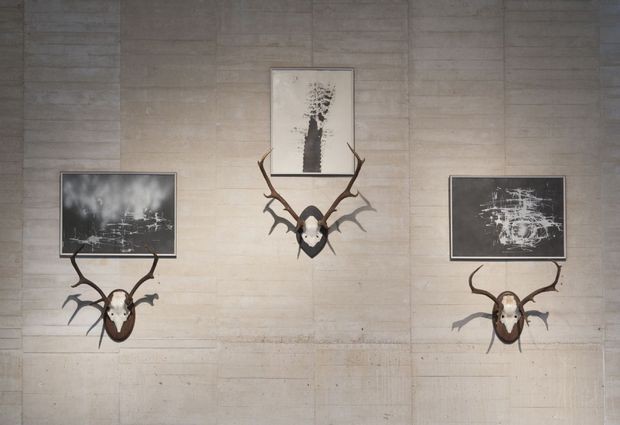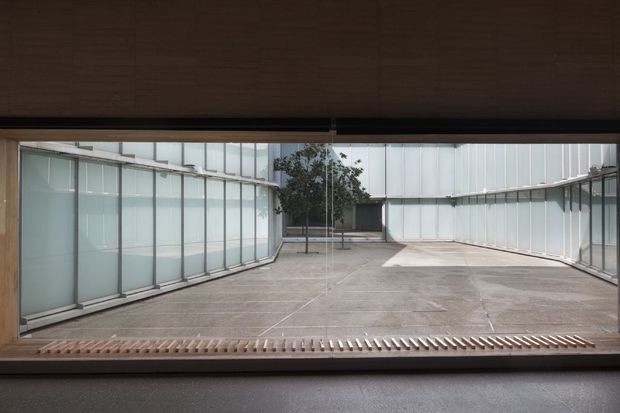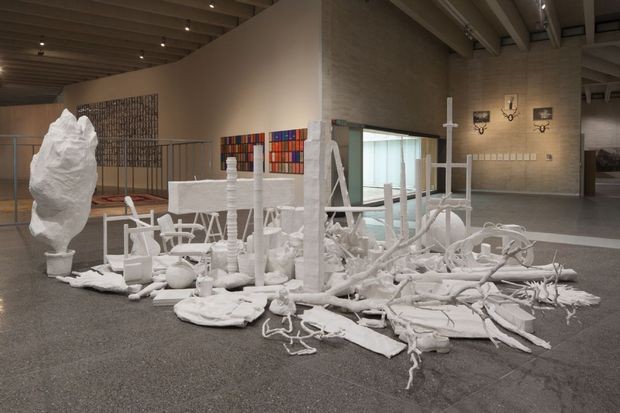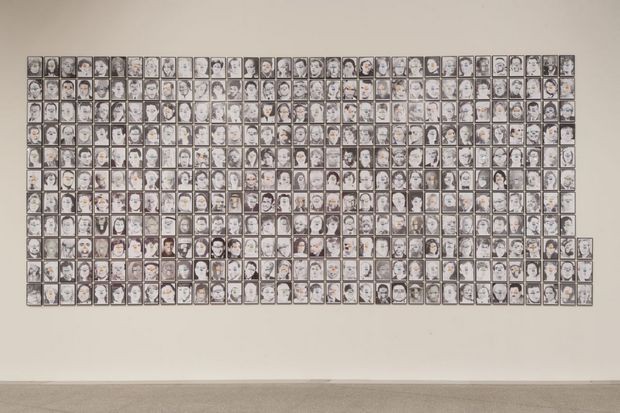Darío Corbeira
Remain Silent or Lie
17 Sep 2016 - 08 Jan 2017

DARÍO CORBEIRA. 3 (5, 7, 11) 7 (31, 37, 41, 43, 47, 53, 59), 1995-96. Courtesy of the artist © VEGAP, 2015-16
DARÍO CORBEIRA
Remain Silent or Lie
Hall 1
17 September 2016 - 8 January 2017
Curatorship: Montserrat Rodríguez Garzo
Coordination: Helena López Camacho
Remain Silent or Lie is the title of the exhibition project created expressly for the MUSAC by the artist Darío Corbeira. The works on show span from the mid-seventies to date, including some recent creations which will be seen in public for the very first time in this exhibition.
The title of the project is taken from a sentence in Jean Paul Sartre’s The Venetian Pariah. In his study, Sartre championed the work of Jacopo Robusti Tintoretto —the artist destined to bookend Renaissance painting— describing the decadent Venice of the second half of the sixteenth century as a city that maintained its habit of remaining silent or lying. The idea of remaining silent or lying suggests a certain parallel between sixteenth century Venice and the West today, posing a reflection that has rather more to do with ends —death and deaths as its paradigm— than with beginnings; more to do with in-between territories than with clearly-defined independent zones; more to do with secant and minimally intersected situations than with well-defined and obsoletely contained situations.
Remain Silent or Lie inhabits a theoretical and practical realm dealing with time in lowercase, Time in uppercase, and with our time, closer to us, accentuating the mise-en-scène of constructions that speak about what ceases to be and outlining a labile and diffuse space-time structure. This structure is underpinned by the articulation of what derives from the artistic focus on a number of subject matters —Working Class, Exhibition, Painting, Illness, Obsolescence, Inner Drawing, Time (our time)— and is organised by the interrelations of thematic nodes, in-between zones, and theoretical reflections on said articulations. These nodes, zones and theoretical reflections explore the aforementioned themes, associated with an analysis of representations of order, the accidental and the significance of death, and with the thinking of Aristotle, Jean-Paul Sartre, Alain Badiou, Dominique Ingres, Paul Valéry, Jacques Lacan and Nicolas Poussin, among others.
The project, curated by Montserrat Rodríguez Garzo — a psychoanalyst, BA in Geography and History, and Diploma in Archives and Documentation, who has been researching into applications of psychoanalysis in the psycho-social realm, and the mechanics of creating languages in psychoses and art facts since 1998 — posits a reflection on the rationale of the exhibition device, focusing on the derivations from an encounter between two discursive modes: that of the work as artistic thinking, represented here by Corbeira’s works, and that which comes from the use of Lacanian thought as a tool to explore the aesthetic dimensions of art languages. The reflections generated in the encounters with the aesthetic subject (the work) theoretically inform Corbeira’s practice, and that information is coupled with references that can be used to build an aesthetic structure with two faces: one being the complex of meanings, the subjects, and the other comprised, no less importantly, of the syntax that organises the morphologies of the visual phenomenon Remain Silent or Lie conceived as “steps in the constitution of the world in the scopic field.”
Another key aspect of the work with Remain Silent or Lie is an invitation issued to study the work of Corbeira and its adscription to the context in which his practice takes place, with a particular focus on the course of his work in connection with the interrelationship between the socio-political and artistic realms. In order to fulfil those rapprochements, we have devised a working format consisting of conversations between the artist and the curator, held since ..... 2014.
The two theoretical rapprochements to Corbeira’s practice are applied to the encounters between the works of Corbeira and Metzger, and to the currency of the artist’s work, as read by two generations: the artist’s coevals in conversation with historians from the following generation. The first rapprochement will take place at the MUSAC, and will deal with the morphology and syntax of destruction in Corbeira and Metzger. The second rapprochement will be held at La Tabacalera, with the participation of Simón Marchán and Jaime Vindel as invited guests.
Remain Silent or Lie
Hall 1
17 September 2016 - 8 January 2017
Curatorship: Montserrat Rodríguez Garzo
Coordination: Helena López Camacho
Remain Silent or Lie is the title of the exhibition project created expressly for the MUSAC by the artist Darío Corbeira. The works on show span from the mid-seventies to date, including some recent creations which will be seen in public for the very first time in this exhibition.
The title of the project is taken from a sentence in Jean Paul Sartre’s The Venetian Pariah. In his study, Sartre championed the work of Jacopo Robusti Tintoretto —the artist destined to bookend Renaissance painting— describing the decadent Venice of the second half of the sixteenth century as a city that maintained its habit of remaining silent or lying. The idea of remaining silent or lying suggests a certain parallel between sixteenth century Venice and the West today, posing a reflection that has rather more to do with ends —death and deaths as its paradigm— than with beginnings; more to do with in-between territories than with clearly-defined independent zones; more to do with secant and minimally intersected situations than with well-defined and obsoletely contained situations.
Remain Silent or Lie inhabits a theoretical and practical realm dealing with time in lowercase, Time in uppercase, and with our time, closer to us, accentuating the mise-en-scène of constructions that speak about what ceases to be and outlining a labile and diffuse space-time structure. This structure is underpinned by the articulation of what derives from the artistic focus on a number of subject matters —Working Class, Exhibition, Painting, Illness, Obsolescence, Inner Drawing, Time (our time)— and is organised by the interrelations of thematic nodes, in-between zones, and theoretical reflections on said articulations. These nodes, zones and theoretical reflections explore the aforementioned themes, associated with an analysis of representations of order, the accidental and the significance of death, and with the thinking of Aristotle, Jean-Paul Sartre, Alain Badiou, Dominique Ingres, Paul Valéry, Jacques Lacan and Nicolas Poussin, among others.
The project, curated by Montserrat Rodríguez Garzo — a psychoanalyst, BA in Geography and History, and Diploma in Archives and Documentation, who has been researching into applications of psychoanalysis in the psycho-social realm, and the mechanics of creating languages in psychoses and art facts since 1998 — posits a reflection on the rationale of the exhibition device, focusing on the derivations from an encounter between two discursive modes: that of the work as artistic thinking, represented here by Corbeira’s works, and that which comes from the use of Lacanian thought as a tool to explore the aesthetic dimensions of art languages. The reflections generated in the encounters with the aesthetic subject (the work) theoretically inform Corbeira’s practice, and that information is coupled with references that can be used to build an aesthetic structure with two faces: one being the complex of meanings, the subjects, and the other comprised, no less importantly, of the syntax that organises the morphologies of the visual phenomenon Remain Silent or Lie conceived as “steps in the constitution of the world in the scopic field.”
Another key aspect of the work with Remain Silent or Lie is an invitation issued to study the work of Corbeira and its adscription to the context in which his practice takes place, with a particular focus on the course of his work in connection with the interrelationship between the socio-political and artistic realms. In order to fulfil those rapprochements, we have devised a working format consisting of conversations between the artist and the curator, held since ..... 2014.
The two theoretical rapprochements to Corbeira’s practice are applied to the encounters between the works of Corbeira and Metzger, and to the currency of the artist’s work, as read by two generations: the artist’s coevals in conversation with historians from the following generation. The first rapprochement will take place at the MUSAC, and will deal with the morphology and syntax of destruction in Corbeira and Metzger. The second rapprochement will be held at La Tabacalera, with the participation of Simón Marchán and Jaime Vindel as invited guests.






